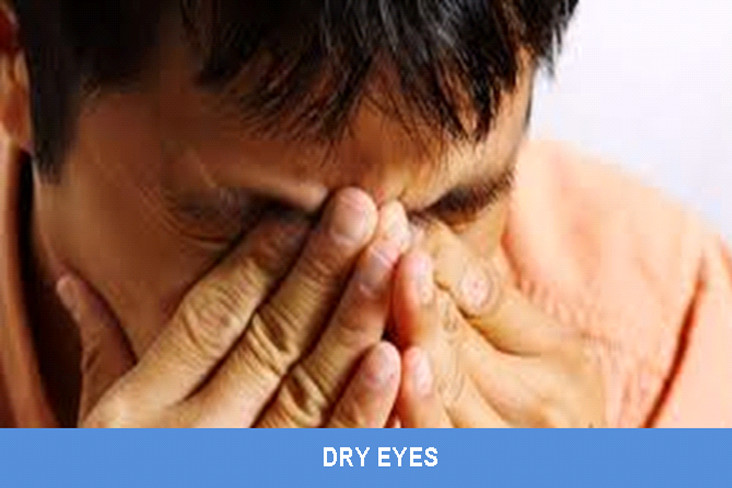Lacrimation is the secretion of tears, which often serve to clean and lubricate the eyes in response to irritation of the eyes. Tears formed through crying are associated with strong internal emotions such as sorrow, awe and pleasure. Laughing and yawning also result in production of tears. They also contain enzymes that neutralize the microorganisms that colonize the eye. Tears are essential for good eye health.
DRY EYE SYNDROME
In dry eye syndrome, the eye doesn’t produce enough tears, or the tears have a chemical composition that causes them to evaporate too quickly. Dry eye syndrome is caused by a chronic lack of sufficient lubrication and moisture on the surface of the eye. Its consequences range from subtle and constant irritation to inflammation of the eye. If left untreated, this condition can lead to pain, ulcers, or scars on the cornea, and some loss of vision. However, permanent loss of vision from dry eye is uncommon.
DRY EYE SYMPTOMS
Persistent dryness, scratchiness, red eyes and a burning sensation are common symptoms of dry eyes. These symptoms alone may prompt your eye doctor to diagnose dry eye syndrome.
Dry eyes can become red and irritated, causing a feeling of scratchiness.
But sometimes your eye doctor may want to measure the amount of tears in your eyes. A thin strip of filter paper placed under the lower eyelid, called a Schirmer test, is one way to measure tear production.
Another symptom of dry eyes is a “foreign body sensation,” which is a feeling that something is in your eye.
And it may seem odd, but dry eye syndrome also can cause watery eyes. This is because dryness on the eye’s surface sometimes will overstimulate production of the watery component of your tears as a protective mechanism.
CAUSES OF DRY EYE
Dry eye syndrome has several causes:
- It occurs as a part of the natural aging process, especially during menopause; as a side effect of many medications, or because a dry, dusty or windy climate. Home or office air conditioning or a dry heating system can dry out your eyes. Another cause is insufficient blinking, such as when staring at a computer screen or TV monitor all day.
- Dry eyes are also a symptom of systemic diseases such as lupus, rheumatoid arthritis, Sjogren’s syndrome (a triad of dry eyes, dry mouth, and rheumatoid arthritis).
- Long-term contact lens wear is another cause; in fact, dry eyes are the most common complaint among long term contact lens wearers. Recent research indicates that contact lens wear and dry eyes can be a vicious cycle. Dry eye syndrome makes contact lenses feel uncomfortable, and the rubbing of the lenses against the conjunctiva seems to be a cause of dry eyes.
- Incomplete closure of the eyelids, eyelid disease and a deficiency of the tear-producing glands are other causes.
TREATMENT FOR DRY EYES
Dry eye syndrome is an ongoing condition that may not be completely and permanently cured (depends on the cause), but the accompanying dryness, scratchiness and burning can be managed.
- Lubricants: Your eye doctor may prescribe artificial tears, which are lubricating eye drops that may alleviate the dry, scratching feeling.
- Contact lens: If you wear contact lenses, be aware that many eye drops, cannot be used while your contacts are in your eyes. Your doctor can prescribe eye drops, which are safe and effective over contact lenses.
- Blocked meibomian glands: Meibomian gland dysfunction (MGD) is now recognized as a primary cause and contributor to most cases of dry eye. Lid compresses and massages help in relieving from meibomian gland dysfunction.
- Environment. If the problem is environmental, wear sunglasses when outdoors to reduce exposure to sun, wind and dust.
- Nutrition and hydration. Doctors sometimes recommend special nutritional supplements for dry eyes. Studies have found that supplements containing omega-3 fatty acids can decrease dry eye symptoms. Good sources of omega-3s include cold-water fish, such as sardines, cod, herring and salmon. Some eye doctors also recommend flaxseed oil to get rid of dry eyes.
- In case of persistent dry eyes, your doctor will recommend specialized tests and treatment for relief of symptoms like Punctal occlusion. Temporary or permanent silicone plugs can be inserted in the lacrimal (tear) drainage ducts in your eyelids to keep tears on your eye from draining away as quickly. Called lacrimal plugs or punctual plugs, they can be inserted painlessly while you’re in the eye doctor’s office and normally are not felt once inserted.

